El Zodíaco Familiar blends Chinese zodiac with Mexican and Chicane culture
Thirteen artists share unique voices using various mediums
November 11, 2021
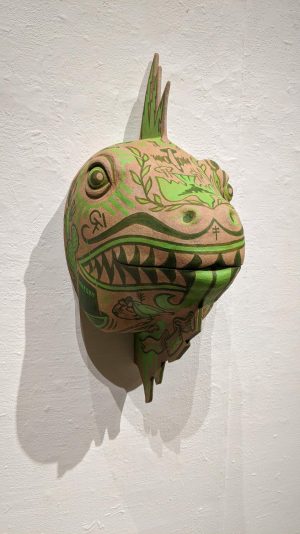
Upon entering the El Zodíaco Familiar exhibit at the Sarah Spurgeon Gallery, dozens of students, faculty and community members encountered a vast array of vibrantly-decorated creature heads mounted along the stark white walls. The crowd buzzed with inquisitive cheer while marveling at the ceramic and mixed media sculptures on Thursday evening, Nov. 4.
The exhibit was created by El Paso, Texas native George Rodriguez, with the intent to blend the concept of the Chinese zodiac and the heritage of 13 other Mexican and “Chicane,” (the term for “Chicano” used by the artists) collaborators.
Each collaborator worked on the creature corresponding with their birth year and Chinese zodiac animal. According to Rodriguez, he searched diligently to fill each zodiac position with an artist that would bring a unique vision to the project.
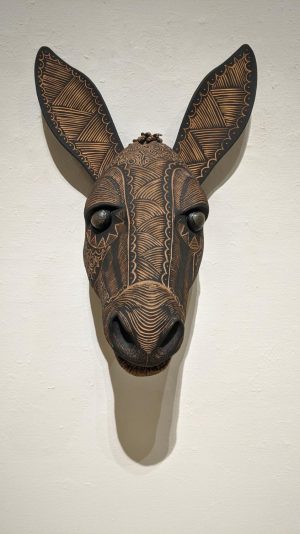
“This isn’t just an art exhibit,” said Heather Horn Johnson, the Sarah Spurgeon Gallery manager. “We’re talking about culture and the melding of culture. You see their unique backgrounds and influences emerging in these different zodiac pieces.”
Rodriguez hosted an artist’s talk in the SURC Theatre before the reception at the gallery, during which he presented information about the background and involvement of each collaborator. The collaborators are from places like Rodriguez’s hometown El Paso, Arizona, California, various locations in Mexico and on the east coast.
“I hope that people come in and see my artwork, but I also hope that they research the individual artwork of the collaborators,” Rodriguez said. “I worked with them because they’re all amazing.”
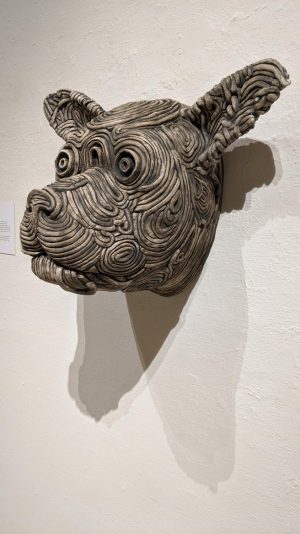
The collaborators include: Javier Barboza, Alejandra Carrillo-Estrada, Eric J. García, Jon Gomez, Carolina Jiménez, Gabriel Marquez, Gustavo Martinez, Marilyn Montúfar, Gabriela Ramírez Michel, Yosimar Reyes, Moises Salazar, Samirah Steinmeyer and Christie Tirado.
“The fact that George collaborated with 13 artists to put together this show is unique and meaningful,” Horn Johnson said. “Oftentimes one artist makes their own particular work, but here it’s a blend of artistic sensibilities and approaches that makes it really special.”
The collaborators’ occupations range from photographers, educators, jewelers and tattoo artists, according to Rodriguez.
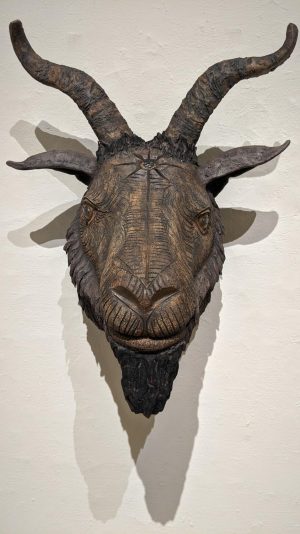
Their mediums range from spoken word poetry (in the sculpture “Guerrero” of the Quetzalcoatl by Yosimar Reyes, representing the dragon), woven threads and fabrics (in the “Venado Azul de los Cielos Claros” sculpture by Carolina Jiménez) and metalsmithing (in the “Brava Nepantla” jaguar sculpture by Alejandra Carrillo-Estrada).
Many sculptures focused on ceramics with technicolor painting, jewelry and even glitter as featured on the “Grillx” chapulín sculpture by Moises Salazar, representing the rat. The Águila (eagle) sculpture by Jon Gomez and Javier Barboza included “alternate reality” art visible only by scanning a code on a phone.
Rodriguez said his favorite sculpture in the exhibit fluctuates based on his mood.
“Some days, I’ll go in and the brightness of this piece in front of me, ‘La Peyotera’ [the monkey], the vibrancy of the color uplifts me and I’m feeling that kind of joy,” Rodriguez said. “Sometimes I need something that’s a little bit more grounding and a little more somber, so ‘La Cabra’ [the goat] back there has a weight to it.”
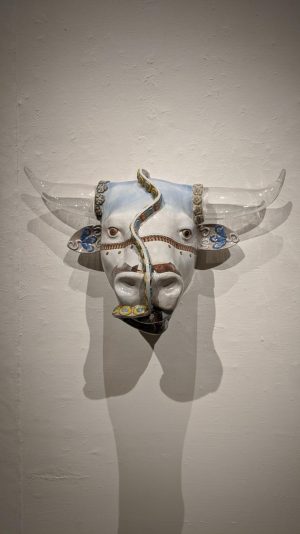
The goat sculpture by Gustavo Martinez, “La Cabra-Cabron Cabrona,” was a favorite of numerous event-goers for its life-like qualities.
“When I looked at the goat, it made me feel almost as if it was an actual animal head,” junior graphic design major Paola García said.
García also appreciated the jaguar sculpture because she said it looked both human and animalistic at the same time.
The “Cacomixtle del Desierto Sonorense” sculpture by Samirah Steinmeyer was one of Horn Johnson’s favorite pieces.
“It’s made out of a different clay than the other zodiac heads,” Horn Johnson said. “It’s from the Sonoran desert, the region where the artist lives. She uses the earth that’s beneath her. I like the stripes, the color and the luminous eyes.”
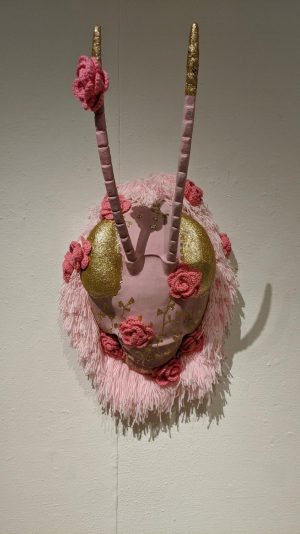
Other attendees appreciated pieces with surprise elements, like the “Recollections – Atravesando con el Toro” sculpture by Marilyn Montúfar.
Senior Studio Art and Visual Art Teaching and Secondary Education major Maya Stoker said the glass on the sculpture was unexpected, because “horns are seen as aggressive, so seeing them as this clear glass that’s really delicate is really interesting.”
Rodriguez said he hopes viewers of the exhibit will feel a sense of childlike joy that isn’t always present in a gallery setting.
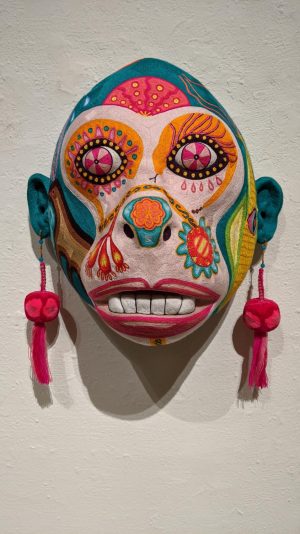
“With the storytelling of the animals, it’s playful,” Rodriguez said. “I hope that people will find their birth year and make a connection to that animal, whether good or bad.”
El Zodíaco Familiar is the fifth iteration of the Chinese zodiac sculptures created by Rodriguez.
Rodriguez said he started by creating a ceramic head for each creature using the molds from past iterations. Each head was made in the color that the collaborator requested. He then sent the heads to some of the artists, while others traveled to work with him in Philadelphia where his studio is located.
Each artist added their own interpretation to their zodiac creatures which created a diverse medley of perspectives. The collaborators focused on various cultural aspects of immigration and migrant work, as well as queer identities and how they are perceived in Mexican and Chicane culture.
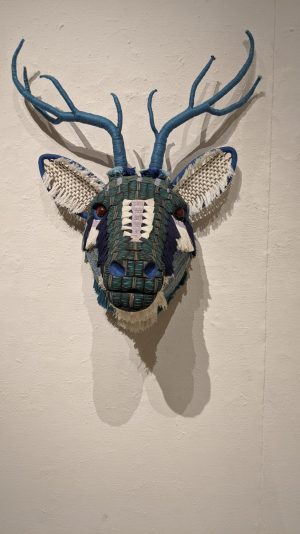
The project was born out of the pandemic, when Rodriguez said he was misplaced from his studio and couldn’t travel to his other studio. He hoped to organize a collaboration that would make the most out of the quarantine.
“We’re happy to be able to have public programs again after not doing it for quite some time,” Horn Johnson said.
Johnson said that the artist’s statements and poetry are available in both Spanish and English to promote inclusivity and allow viewers to practice their language skills.
Rodriguez said he hopes to show people who are unaware that art can be a career path how they can find ways to showcase their art like he does.
“My community inspires me most,” Rodriguez said. “The impetus for me to make work is to have a little bit of representation through my own story.”
Rodriguez said that he aspires to take the El Zodíaco Familiar exhibit to California, Arizona, El Paso, Philadelphia and more locations in the future.
This story has been updated.


